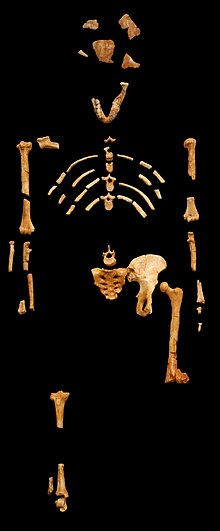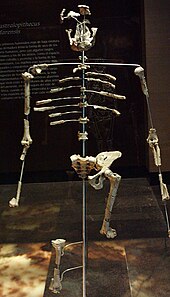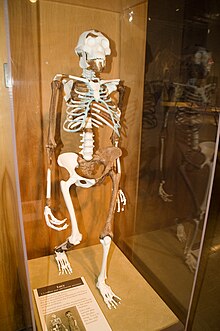Lucy (Australopithecus)
From Wikipedia, the free encyclopedia
 | |
| Catalog number | AL 288-1 |
|---|---|
| Common name | Lucy |
| Species | Australopithecus afarensis |
| Age | 3.2 million years[1] |
| Place discovered | Afar Depression, Ethiopia |
| Date discovered | November 24, 1974 |
| Discovered by | Donald Johanson Maurice Taieb Yves Coppens Tom Gray[2] |
Lucy is the common name of AL 288-1, several hundred pieces of bone representing about 40% of the skeleton of a female Australopithecus afarensis. In Ethiopia it is also known as Dinkinesh which means "you are marvelous" in the Amharic language.[3] It was discovered in 1974 at Hadar in the Awash Valley of the Afar Triangle inEthiopia. In paleoanthropology, usually only fossil fragments are found and only rarely are skulls or ribs uncovered intact; thus this discovery was extraordinary and provided an enormous amount of scientific evidence. Lucy is estimated to have lived 3.2 million years ago,[1][4] and is classified as a hominin.[5]
The skeleton shows evidence of small skull capacity akin to that of apes and of bipedal upright walk akin to that of humans, supporting the debated view that bipedalism preceded increase in brain size in human evolution.[6][7]
Beginning in 2007, the fossil and associated Ethiopian artifacts toured the United States for six years, as an exhibition entitled Lucy’s Legacy: The Hidden Treasures of Ethiopia. Part of the proceeds of admission fees were to go to the Ethiopian government for improvements to its museums. Lucy and the exhibit were returned to Ethiopia on 7 May 2013.
Contents
[hide]Discovery[edit]
French geologist Maurice Taieb discovered the Hadar Formation in the Afar Triangle of Ethiopia in 1972. He formed the International Afar Research Expedition (IARE), inviting three scientists from three countries to co-direct the research. These wereDonald Johanson, an American anthropologist and curator at the Cleveland Museum of Natural History, who later became the Founding Director of Berkeley, California's Institute of Human Origins, now part of Arizona State University; Mary Leakey, the noted famous British archaeologist; and Yves Coppens, a French-born paleontologist now based at the Collège de France. An expedition was formed with four American and seven French participants, and in the autumn of 1973, the team surveyed Hadar for fossils and artifacts related to the origin of humans.[8]
In November 1973, near the end of the first field season, Johanson noticed a fossil of the upper end of a shinbone, which had been sliced slightly at the front. The lower end of a femur was found near it, and when he fitted them together, the angle of the knee joint clearly showed that this fossil, reference AL 129-1, was an upright walking hominid. The fossil is more than three million years old, much older than any other hominid fossils known at the time. The site lay about 2.5 kilometres (1.6 mi) from the site "Lucy" was subsequently found, in a rock stratum 200 feet deeper than that in which the other fragments were found.[9][10]
The team returned for the second field season the following year and found hominid jaws. Then, on the morning of November 24, 1974, near the Awash River, Johanson abandoned a plan to update his field notes and joined graduate student Tom Gray to search Locality 162 for bone fossils.[11]
Both Donald Johanson and Tom Gray spent two hours on the increasingly hot arid plain, surveying the dusty terrain. On a hunch on their return to their vehicle, Johanson decided to look at the bottom of a small gully that had been checked at least twice before by other workers. At first view, nothing was immediately visible, but as they turned to leave, a fossil caught Johanson's eye: an arm bone fragment lying on the slope. Near it lay a fragment from the back of a small skull. They noticed part of a femur (thigh bone) a few feet (around 1 m) away. As they explored further, they found more and more bones on the slope, including vertebrae, part of a pelvis, ribs, and pieces of jaw. They marked the spot and returned to camp, excited at finding so many pieces apparently from one individual hominid.[2][12]
In the afternoon, everyone on the expedition returned to the gully, sectioning off the site and preparing for careful collection, which eventually took three weeks. That first evening they celebrated at the camp. At some stage during the evening, they nicknamed the fossil AL 288-1 as Lucy, after the Beatles' song "Lucy in the Sky with Diamonds", which was being played loudly and repeatedly on a tape recorder in the camp.[4]
Over the next three weeks, the team found several hundred pieces or fragments of bone, with no duplication, confirming their original speculation that the pieces were from a single skeleton. As the team analyzed the fossil further, they calculated that an amazing 40% of a hominid skeleton had been recovered. Johanson assessed it as female, based on the one complete pelvic bone and sacrum, which indicated the width of the pelvic opening.[4]
Lucy was 1.1 m (3 ft 7 in) tall,[13] weighed 29 kg (64 lb), and (by reconstruction) looked somewhat like a chimpanzee. Although the creature had a small brain, the pelvis and leg bones were almost identical in function to those of modern humans, showing with certainty that these hominids had walked erect.[14] Under an agreement with the government of Ethiopia, Johanson brought the skeleton back to the Cleveland Museum of Natural History in Ohio, where it was reconstructed by Owen Lovejoy. It was returned to Ethiopia according to agreement some 9 years later. Lucy as a fossil hominid captured public notice, becoming almost a household name at the time.
Further discoveries of A. afarensis specimens occurred during the 1970s, giving anthropologists a better understanding of the range of variability and sexual dimorphism of the species. An even more complete skeleton of an earlier hominid species has been found: "Ardi", dated at 4.4 million years ago.[15] It was found in 1992, with the results not fully published until October 2009.[15]
Age estimates of fossil[edit]
The Lucy fossil was dated reliably in 1990–1992 by applying the argon-argon radiometric dating method to the volcanic ash surrounding it. Initial attempts were made in 1974 to estimate the age of the fossil using the potassium-argon radiometric dating method in James Aronson's laboratory at CWRU, now moved to Dartmouth. These efforts by Maurice Taieb and Aronson were hindered by the scarcity of datable crystals, the fact that the volcanic rocks in the area of concern were chemically altered or reworked, and the complete absence of pumice clasts at Hadar. Lucy's skeleton occurs in the part of the Hadar sequence that accumulated with the fastest rate of deposition, which partly accounts for her excellent preservation. The older ash was about 18 m below the fossil and the younger ash only 1 m below, closely indicating her age of deposition.
Fieldwork at Hadar was suspended in the winter of 1976–1977. When it resumed thirteen years later in 1990, the more precise argon-argon technology had been improved by Derek York from the University of Toronto. In 1990–1992, two suitable samples of ash found by Aronson and Robert Walter were argon-argon dated by Walter at 3.22 and 3.18 million years in the geochronology laboratory of the Institute of Human Origins.[16]
Notable characteristics[edit]
Ambulation[edit]
One of Lucy's most striking characteristics is a valgus knee,[17] which indicates that she normally moved by walking upright. The femoral head of the knee was small and the femoral neck was short, both primitive characteristics. Her greater trochanter, however, was clearly derived, being short and human-like rather taller than the femoral head. The length ratio of her humerus to femur was 84.6% compared to 71.8% for modern humans and 97.8% for common chimpanzees, indicating that either the arms of A. afarensis were beginning to shorten, the legs were beginning to lengthen, or both were occurring simultaneously. Lucy also had a lumbar curve, another indicator of habitual bipedalism. Lucy likely had non-pathological (physiologic) flat feet, not to be confused with pes planus, though other afarensis individuals appear to have had arched feet.[18]
Pelvic girdle[edit]
Johanson recovered Lucy's left innominate bone and sacrum. Though the sacrum was remarkably well preserved, the innominate was distorted, leading to two different reconstructions. The first reconstruction had little iliac flare and virtually no anterior wrap, creating an ilium that greatly resembled that of an ape. However, this reconstruction proved to be faulty, as the superior pubic rami would not have been able to connect if the right ilium was identical to the left.
A later reconstruction by Tim White showed a broad iliac flare and a definite anterior wrap, indicating that Lucy had an unusually broad inner acetabular distance and unusually long superior pubic rami. Her pubic arch was over 90 degrees, similar to modern human females. Her acetabulum, however, was small and primitive.
Cranial specimens[edit]
The cranial evidence recovered from Lucy is far less derived than her postcranium. Her neurocranium is small and primitive, while she possesses more spatulate canines than apes. The cranial capacity was about 375 to 500 cc.
Ribs[edit]
Australopithecus afarensis also seems to have had the same conical rib-cage found in Apes like the Chimpanzee and Gorilla, indicating a longer intestine necessary for digesting plant matter. Fully 60% of the blood supply of Apes is used in the digestion process, greatly limiting the brain functions (which consume about 10% of the circulation). Heavier maxilliary masticatory musculature of the jaws also would impede the enlargement of the skull. These muscles seem to have weakened in the evolution of humans with the loss of the myosin gene MYH16, a two base pair deletion, which occurred only about 2.4 million years ago.
Other findings[edit]
A study of the mandibular structure of a number of specimens of Au. Afarensis indicated that Lucy's jaw was rather unlike other hominins, having a more gorilla-like appearance.[19] Rak et al. consider that this mandible structure arose "independently in gorillas and hominins", but that Au. Afarensis is therefore "too derived to occupy a position as a common ancestor of both the Homo and robust australopith clades".[5]
Death[edit]
Lucy's cause of death is unknown. She does not show the signs of post-mortem bone damage characteristic of animals killed by predators and then scavenged. The only visible damage to Lucy's bones is a single carnivore tooth puncture mark on the top of her left pubic bone, believed to have occurred at or around the time of death, that may not be related to her death. Her erupted and slightly worn third molars and the development of her bones indicate that she was fully adult with completed skeletal development. There are indications of degenerative disease to her vertebrae, but this is not necessarily an indicator of old age. It is believed that she was a mature, but young, adult when she died.[20]
Exhibitions[edit]
Lucy is preserved at the National Museum of Ethiopia in Addis Ababa. A plaster replica is displayed instead of the original skeleton. A cast of the original skeleton in its reconstructed form remains on display at the Cleveland Museum of Natural History.[21] A diorama of Australopithecus afarensis and other human predecessors showing each species in its habitat and demonstrating the behaviors and capabilities that scientists believe it had is displayed in the Hall of Human Biology and Evolution at the American Museum of Natural History in New York City. A cast of Lucy's skeleton as well as a reconstruction of Lucy is on display at The Field Museum in Chicago in their Evolving Planet exhibition.
US tour[edit]
A six-year exhibition tour of the United States, titled Lucy’s Legacy: The Hidden Treasures of Ethiopia, featured the Lucy fossil as well as over 100 artifacts from ancient times to the present, was displayed 2008-2013. The tour was approved by the Ethiopian government and organized in collaboration with the Houston Museum of Natural Science, where it had been on display from August 31, 2007 until September 1, 2008.[22]
An undisclosed proportion of the proceeds from the tour is to go toward modernizing Ethiopia's museums.[23] The U.S. Department of State also approved the tour. There was controversy in advance of the tour over concerns about the fragility of the specimens, with various experts, including paleoanthropologist Owen Lovejoy and anthropologist and conservationist Richard Leakey, publicly stating their opposition. For these reasons, The Smithsonian Institution and Cleveland Museum of Natural History were among museums declining to host the exhibits.[24]
The fossil's discoverer Don Johanson stated that although he was somewhat uneasy about the possibility of damage, he did not oppose exhibiting Lucy, as it will help to raise awareness of human-origins studies. The museum is making arrangements for the exhibits to be shown at as many as ten other museums. The exhibit was shown at thePacific Science Center in Seattle, Washington where it was displayed from October 4, 2008 - March 8, 2009.[23] In September 2008, between the exhibits in Houston and Seattle, the fossils were taken to the University of Texas at Austin for 10 days to complete the first ever high resolution CT scan of the fossil.[25]
Lucy opened at Discovery Times Square Exposition, a facility located in New York City, on June 24, 2009. The Australopithecus afarensis was on display until October 25, 2009.[26] In New York, the exhibition will include Ida (Plate B), the other half of the recently announced Darwinius masilae fossil.[27]
Ethiopia celebrated the return of Lucy on 7 May, 2013.[28]
Criticisms[edit]
Historian of science Londa Schiebinger questions the claim that Johanson's team made concerning Lucy's sex, citing that they wrote "the pelvic opening in hominids has to be proportionately larger in females than in males to allow for the birth of larger-brained infants." Contradicting this evidence was the timing of development of large hominid brains. Schiebinger continues to critique the assumptions made concerning Lucy's sex based upon the skeleton's size.[29]
See also[edit]
- Ardi, more complete skeleton of earlier hominid species
- List of human evolution fossils
- Selam, a young female A. afarensis fossil from Ethiopia
- Lucy (2014 film) features the hominin in several scenes and implies that Lucy is the oldest discovered ancestor of mankind




No comments:
Post a Comment